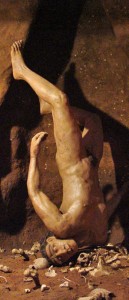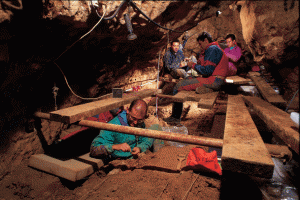 Atapuerca Mountains in Spain is in ancient region located in the Burgos province. It is situated close to Ibeas de Juarros and a small town with the same name. There are several caves in the areas where stone tools and fossils of the earliest Hominians of Western Europe have been found.
Atapuerca Mountains in Spain is in ancient region located in the Burgos province. It is situated close to Ibeas de Juarros and a small town with the same name. There are several caves in the areas where stone tools and fossils of the earliest Hominians of Western Europe have been found.
Sima de los Huesos site in the Atapuerca complex contain the skeletal remains of 28 individuals in small mud breccias under an accumulation of the cave bear.
The dating estimates of 200 and 320 kyr were mainly based on the methods which were use don the bones but these figures were made not quite accurate.
A new discovery had been made at the location of several human bones which were underlying an in Situ speleothem. The analysis of the upper body and the lower body bones suggest that the specimens found there would have to be of the hominids from 4 to 6 million years ago.
The sites in the area had been found during a construction work of railway cuts through Elefante, Galeria and Gran Dolina along with the caves of Sima de los Huesos. In the year 1964, scientific excavation started in the area led by Francisco Jorda Cerda and human remains of several ages have been found in the area which varies from the Bronze Age man to the modern man.
The pit of Bones
 Sima de los Huesos means pit of bones. The site is situated at the bottom of a chimney and can be reached through the caves by scrambling through the Cueva Mayor caves. Since 1997, the team which carried out the excavations in the area has found human bones exceeding 5,500 in numbers which date back to more than 350,000 years and correspond to Middle Pleistocene.
Sima de los Huesos means pit of bones. The site is situated at the bottom of a chimney and can be reached through the caves by scrambling through the Cueva Mayor caves. Since 1997, the team which carried out the excavations in the area has found human bones exceeding 5,500 in numbers which date back to more than 350,000 years and correspond to Middle Pleistocene.
In all close to 28 skeletons of Homo heidelbergensis species have been found along with the remains of the Ursus deningeri and Excalibur, a biface. It is believed that the Acheulean axe which is made from red quartzite had been a ritual of some kind being offered at a funeral. Almost 90% of the remains of the homo heidelbergensis have been found from this site.
There is a wide range of bones which have been found from this site which include a full cranium which is nicknamed Miguelon and fragments of several other craniums. Another skull found from the area was called
Agamenon and one which was called Rui. A full pelvis was also found from the pit which was given the name Elvis, from Elvis Presley. Several postcranial bones, teeth, mandibles, foot and hand bones, ribs, vertebrae etc have also been found in the area. A child had been found with carniosynostosis dating back to 530,000 BP and this provides the evidence of food sharing in the early humans.
The excavators working on the site suggest that the amount of bones found in the pit could represent a burial practice which might have been used by the inhabitants. The theory suggests that there is are few small bones in the caves and that the remains might have been washed into the area due to natural reasons.